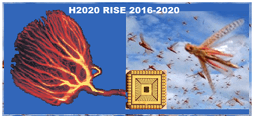Siavash Bahrami is a PhD candidate at Universiti Putra Malaysia (UPM), who is working on multimodal deep neural networks using acoustic and visual data for developing an active road safety system intended for autonomous and semi-autonomous vehicles. As part of the STEP2DYNA project working on work package 4, Siavash completed a 6 month secondment at the University of Lincoln.

Recently Siavash presented a paper titled “Acoustic Feature Analysis for Wet and Dry Road Surface Classification Using Two-stream CNN” during the 12th International Conference on Information and Multimedia Technology (ICIMT 2020). The data utilised for training and testing the proposed CNN architectures were collected during Siavash’s secondment in the UK. Despite the strains caused by the global pandemic Siavash managed to complete his secondment and collect all the data that was needed for his PhD thesis and the ULTRACEPT project with the help of UoL and UPM project members.

ICIMT 2020 was scheduled to take place between 11th and 13th December 2020 in Zhuhai, China, but due to the pandemic it was instead held as a virtual conference. The aim of ICIMT is to provide a platform for researchers, engineers, academics and industrial professionals from all over the world to present their research results and development activities in Information and Multimedia Technology. This conference provides opportunity for delegates to exchange new ideas and applications to establish business or research relations and to find global partners for future collaboration.
Professor Shigang Yue (ULTRACEPT Project Coordinator) and Associate Professor Dr. Shyamala Doraisamy (ULTRACEPT Project partner Lead for UPM) each chaired one of the conference sessions.

Siavash Bahrami, Shyamala Doraisamy, Azreen Azman, Nurul Amelina Nasharuddin, and Shigang Yue. 2020. “Acoustic Feature Analysis for Wet and Dry Road Surface Classification Using Two-stream CNN.” In 2020 4th International Conference on Computer Science and Artificial Intelligence (CSAI 2020). Association for Computing Machinery, New York, NY, USA, 194–200. DOI:https://doi.org/10.1145/3445815.3445847
Acoustic Feature Analysis for Wet and Dry Road Surface Classification Using Two-stream CNN – Abstract
Road surface wetness affects road safety and is one of the main reasons for weather-related accidents. Study on road surface classification is not only vital for future driverless vehicles but also important to the development of current vehicle active safety systems. In recent years, studies on road surface wetness classification using acoustic signals have been on the rise. Detection of road surface wetness from acoustic signals involve analysis of signal changes over time and frequency-domain caused by interaction of the tyre and the wet road surface to determine the suitable features. In this paper, two single stream CNN architectures have been investigated. The first architecture uses MFCCs and the other uses temporal and spectral features as the input for road surface wetness detection. A two-stream CNN architecture that merges the MFCCs and spectral feature sets by concatenating the outputs of the two streams is proposed for further improving classification performance of road surface wetness detection. Acoustic signals of wet and dry road surface conditions were recorded with two microphones instrumented on two different cars in a controlled environment. Experimentation and comparative performance evaluations against single stream architectures and the two-stream architecture were performed. Results shows that the accuracy performance of the proposed two-stream CNN architecture is significantly higher compared to single stream CNN for road surface wetness detection.


Read more about Siavash’s work in his blog post here.
